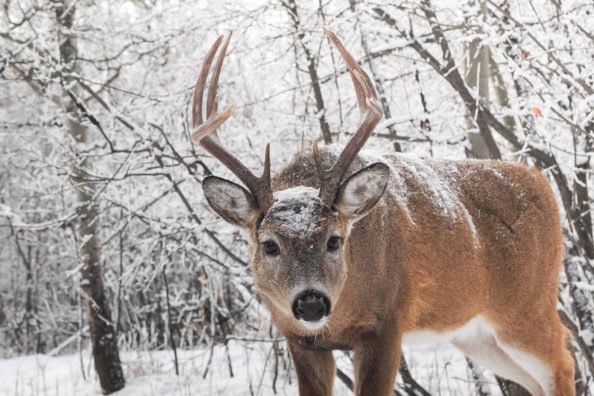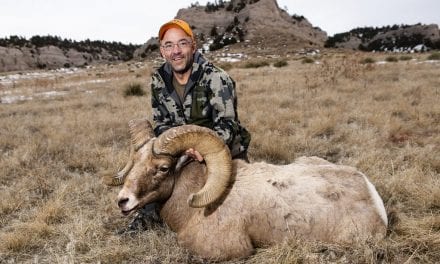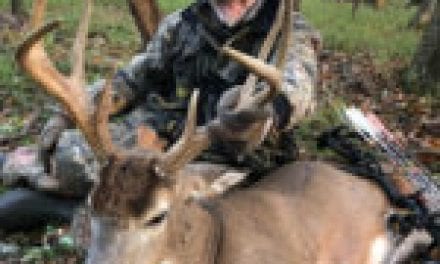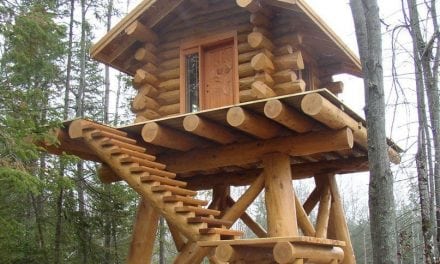
Tough conditions aren’t just brutal for humans — they can have a serious impact on wildlife too.
If you’ve ever seen the crazy injuries a deer can survive — like a crossbow bolt through the skull or gaping wounds from a run in with an SUV — you already know they’re incredibly resilient creatures. While nearly all the game animals we pursue are able to withstand more hardship than people, winter does get the best of some each year. And there are more factors at play affecting them than you might realize.
These are some of the key ones that often make wintertime too much for wildlife to handle.
Winter Weather
Although winter cold is relative depending on which corner of the country you live and hunt in, the winter months are typically the most brutal weather-wise, no matter where you are. Many animals grow a warmer winter coat or employ other adaptations to cope with the cold. These adaptations give the animals an advantage, however it’s worth noting those are only effective up to a certain point.
Sub-zero temperatures, several feet of snow, intense ice storms, and howling winds can keep animals off their feet and conserving energy for days, making them tired and weak. Just like humans, wildlife can suffer from frostbite and hypothermia in harsh weather. Animals that are already sickly or deer that are worn down from the rut are especially susceptible.
Just last year, a major storm wiped out a portion of game and non game animals in Texas, Oklahoma, and Louisiana — states which certainly don’t face the most severe winter conditions in an average year. But those animals faced conditions unlike any they were used to in the past. It was likely a huge shock to the system for them, and many succumbed before spring hit.
That’s not to say that animals only in warmer climates can experience a winter kill from unexpected bad weather. For instance, a brutal winter in Montana a few years back pushed deer and antelope into the critical stage and resulted in some mortality for the two species. Although the state is accustomed to bitter cold and snow in the winter months, the extreme conditions of 2018 were beyond the norm.
Lack of Food
With the harsh winter weather often comes killed crops, frozen ground, and a general lack of food for wildlife. Not to mention the problems of heavy snowfall and ice covering vital food sources. Ever see a food plot torn up by deer after a blizzard? It often forces animals to expend extra energy pawing at the ground trying to dig them up. With weight and energy levels already low, animals are in dire need of food to refuel them to survive blustery weather.
Brutal winters that decimate food and water sources can force animals to feed on haystacks and other materials that their stomachs simply cannot process correctly. This can lead to deadly bloat. They can also die from starvation, with their stomachs completely full of hay.
While some people think feeding deer and other animals will help, Doug Brimeyer, Wyoming Game and Fish Department’s deputy chief of the wildlife division, said it can actually make things worse.
“It can actually worsen the problem,” Brimeyer said in an interview. “Rapid changes to their diet can lead to chemistry changes in their stomach, and they can actually be poisoned from certain types of food that they’re given in the wintertime if it’s changed too rapidly. We have a number of instances where deer have been found dead with full stomachs.”
Lack of Habitat
Along with the lack of nourishment due to the rough winter weather comes a lack of habitat for wildlife as well.
According to wildlife researcher Mike Chamberlain — known in the hunting community as the Wild Turkey Doc — optimal turkey habitat is already in short supply with changes to farming practices, prescribed fires, and other landscape evolution.
“The bottom line is we don’t have the high-quality early successional habitats that we once had,” Chamberlain told me. “Think of areas with lush herbaceous vegetation, areas where birds can nest successfully, they can brood successfully, and they can see.”
Harsh winters can exacerbate the situation for wild turkeys and several other species too.
Some animals will migrate regionally looking for grass and greenery, but devastating winters can keep them from ever finding it. Without proper shelter and protection, animals are exposed to the elements for extended periods, lessening their odds of survival.
Predation
While there’s much debate over how much impact predators truly have on game animals such as deer and turkey, there’s no denying coyotes, bobcats, and the like kill many each year. With wildlife cold, tired, and weak, they become easier prey for the many predators roaming the woods in search of a meal.
According to a recent survey conducted in Delaware, predators might just speed up an inevitable process, but it still causes some stress on deer herds:
“Our findings suggest that predators may simply be removing the ‘doomed surplus’ – the individuals that would have died regardless of predator intervention,” the author wrote.
In this way you can kind of see nature’s design at work. Because that’s the job predators have adapted to – taking out the old, the injured, and the weak. Animals that are the most likely to be negatively affected by the other factors we’ve discussed today.
Diseases and Parasites
Hungry, run down animals are more likely to contract diseases that could weaken them further and even kill them. From avian pox to chronic wasting diseases, several ailments can strike each species harder in the winter months. And if the sickness itself doesn’t do it, the animals’ weakened state makes them easier targets for the previously mentioned predators.
Products featured on Wide Open Spaces are independently selected by our editors. However, when you buy something through our links, we may earn a commission.
NEXT: HOW TO FIND AND SET UP A CAMPING SITE DURING A HUNTING TRIP
WATCH
The post 5 Things That Can Make a Winter Hard on Game Animals appeared first on Wide Open Spaces.













![Gander Outdoors Unveils New Logo, Winning Designer Nets $100 Grand [PICS]](https://www.oelmag.com/wp-content/uploads/2017/07/gander-outdoors-unveils-new-logo-winning-designer-nets-100-grand-pics-440x264.jpg)


